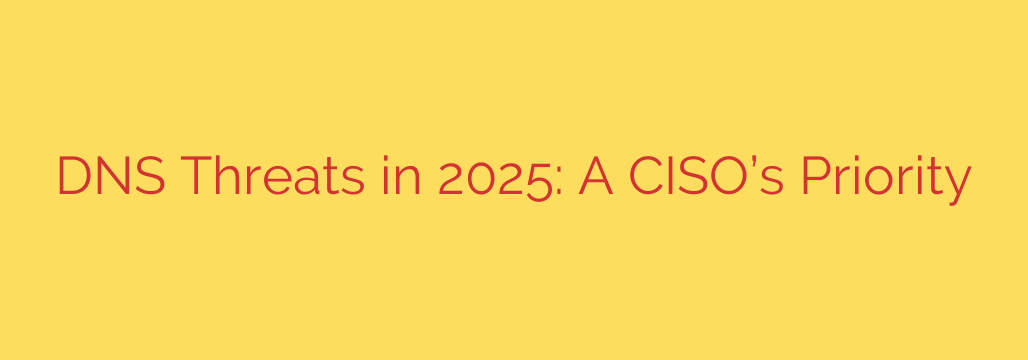
The Evolving Landscape of DNS Threats: Why It Must Be Your Top Security Priority
In the complex world of cybersecurity, it’s often the foundational elements we overlook that pose the greatest risk. As security leaders look toward 2025, the Domain Name System (DNS) is rapidly shifting from a simple internet utility to a primary battleground for sophisticated cyberattacks. Once considered mere IT plumbing, DNS is now a critical security control point that demands strategic attention.
For years, DNS has operated in the background as the internet’s phone book, translating human-readable domain names (like example.com) into machine-readable IP addresses. Its universal presence and trusted nature are precisely what make it such an attractive target. Attackers know that security teams often focus on firewalls, endpoints, and applications, leaving DNS traffic largely unmonitored. This creates a dangerous security blind spot that threat actors are eagerly exploiting.
Top DNS Threats to Watch For in the Coming Years
The nature of DNS attacks is evolving from simple disruptions to stealthy, multi-stage campaigns designed for espionage, data theft, and ransomware delivery. As you refine your security posture, be prepared to counter these specific threats:
DNS Hijacking and Redirection: This classic attack remains potent. By compromising a DNS server or intercepting queries, attackers can redirect your users and employees to malicious websites. These fake sites are often perfect clones of legitimate ones, designed to steal credentials, distribute malware, or trick users into revealing sensitive information. The end user has no idea they’ve been rerouted, making this a highly effective tactic for initial access.
DNS Tunneling for Data Exfiltration: This is one of the most insidious threats. Malware that has already infiltrated a network can use DNS queries to sneak stolen data out, piece by piece. Because DNS traffic is almost always allowed through firewalls, these malicious queries blend in with legitimate traffic. DNS tunneling allows attackers to bypass traditional security controls and exfiltrate sensitive corporate data, intellectual property, and customer information completely undetected.
DNS-Based Distributed Denial of Service (DDoS) Attacks: Threat actors continue to abuse DNS servers to amplify DDoS attacks. By sending small queries to open DNS resolvers with a spoofed target IP address, they can trigger massive response packets directed at the victim. This DNS amplification can overwhelm a target’s network and services, causing costly downtime and operational disruption.
Phishing and Malware Delivery via DNS: Nearly every cyberattack begins with a domain name. Attackers use DNS to support their phishing campaigns, command-and-control (C2) infrastructure, and malware distribution networks. By manipulating DNS records or registering malicious domains, they can effectively weaponize the internet’s core addressing system to ensure their malicious payloads reach their targets.
Actionable Security: Building a Resilient DNS Strategy
Ignoring DNS security is no longer an option. A proactive and layered approach is essential for protecting your organization from these evolving threats. Security leaders should prioritize the following actions:
Implement DNSSEC (Domain Name System Security Extensions): DNSSEC adds a layer of authentication to the DNS process. It uses digital signatures to verify that the DNS data you receive is authentic and has not been tampered with in transit. DNSSEC is a fundamental step in preventing DNS hijacking and cache poisoning.
Leverage Protective DNS (PDNS): A Protective DNS service acts as a first line of defense. It uses real-time threat intelligence to filter DNS requests, automatically blocking connections to known malicious domains associated with phishing, malware, and C2 servers. PDNS prevents attacks before they can even begin by cutting off communication with harmful infrastructure at the earliest possible point.
Monitor All DNS Traffic for Anomalies: You cannot protect what you cannot see. Gaining full visibility into your organization’s DNS traffic is critical. Modern security tools can analyze DNS logs to detect suspicious patterns, such as the high volume of queries indicative of DNS tunneling or communication with newly registered domains. Integrating DNS data into your broader security analytics platform provides invaluable context for threat hunting and incident response.
Adopt a Zero Trust Approach to DNS: Apply Zero Trust principles to your DNS security. Don’t implicitly trust any DNS request, whether it originates inside or outside your network. Every query should be inspected and verified. This mindset shift is crucial for catching sophisticated, internal threats that might otherwise fly under the radar.
Conclusion: Making DNS a Strategic Security Pillar
As we move toward 2025, the role of DNS in cybersecurity has fundamentally changed. It is no longer a passive background service but an active and critical component of your defense-in-depth strategy. By understanding the threats and implementing robust, layered controls, you can transform this potential vulnerability into a powerful source of visibility and protection. Now is the time to ask: is your DNS security ready for the challenges ahead?
Source: https://www.helpnetsecurity.com/2025/08/12/dns-threat-landscape-2025/








